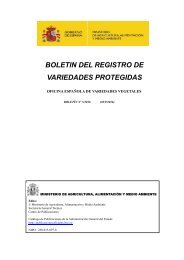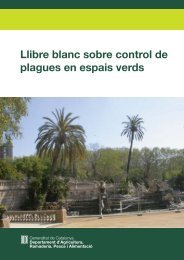I
cpvo_n11
cpvo_n11
You also want an ePaper? Increase the reach of your titles
YUMPU automatically turns print PDFs into web optimized ePapers that Google loves.
General news > Focus on > International cooperation > Legal affairs > Technical news > IT news > To be noted > In practice > Publication<br />
In 2016, the CPVO received and approved the following requests for co-financing of R & D projects.<br />
Harmonisation of resistance tests to diseases for DUS testing<br />
This project was approved at the end of<br />
June 2016. It is a follow-up of a previous<br />
project. It aims to harmonise the resistance<br />
tests in terms of reference material (isolates<br />
and varieties), test conditions and notation<br />
scales, as well as to propose new harmonised<br />
and robust protocols to the CPVO. A focus<br />
for the Harmores 3 project is done on<br />
intermediate resistance, which makes it<br />
more difficult than the previous projects,<br />
but for which harmonised protocols and<br />
reproducible results are of great concern.<br />
The project is coordinated by GEVES with the<br />
following project partners: Naktuinbouw,<br />
INIA, Central Institute for Supervising and<br />
Testing in Agriculture (Czech Republic),<br />
Palacký University (Czech Republic), BSA,<br />
Julius Kühn-Institut (Germany), National<br />
Food Chain Safety Office (Hungary), CREA<br />
(Italy), SASA (UK), CTIFL (France) and ESA.<br />
This project is composed of two parts:<br />
Part 1 (with a duration of 1 year) initiated<br />
in 2016 and Part 2 (with a duration of<br />
2 years) initiated in 2017.<br />
Construction of a European potato database with varieties of common<br />
knowledge and its implementation in the potato DUS testing system<br />
This project was approved in the beginning<br />
of March 2016 and constitutes a follow-up of<br />
the previous R & D projects. The new project<br />
is coordinated by BSA and involves the nine<br />
entrusted EOs for potato. The objective of the<br />
project is to continue the work on the setup<br />
of the EU database for potato. The database<br />
used will be GEMMA, which has to be adapted<br />
to suit the requirements for potato DUS<br />
research. The project lasts 2 years.<br />
Ring tests for strawberry<br />
This project was approved in May 2016. It is<br />
coordinated by the CPVO and includes all the<br />
CPVO entrusted EOs for the species: the BSA,<br />
Coboru, the DGAV (Portugal) and the OEVV.<br />
The project consists in the organisation of ring<br />
tests and meetings with the DUS experts with<br />
the aim of harmonising the implementation<br />
of the protocol for strawberry. This project<br />
lasts 4 years and the final report is expected<br />
to be delivered in 2019.<br />
Sampling, analyses and storage of DNA samples of roses<br />
Regarding this project, the AC agreed in<br />
April this year to end the automatic storage<br />
of samples and to leave it on a voluntary<br />
basis, at the costs of the applicant/breeder<br />
as from September 2016. Clear procedures<br />
and framework of this service will be<br />
prepared by the CPVO, communicated to<br />
the applicants/breeders and presented to<br />
the Administrative Council in October 2016.<br />
> > It news<br />
Sharing online applications system<br />
The CPVO released its online application<br />
system in 2010 and started a pilot project<br />
to assess the feasibility to share this system<br />
with national authorities. The objective<br />
was to investigate under which conditions<br />
it would be possible to transfer the CPVO<br />
online application system to a neutral<br />
website (http://www.plantvarieties.eu)<br />
to allow applications for national listing<br />
or national PVR in the participating EU<br />
countries. The driving idea was to reuse<br />
data from applications in any procedure<br />
in the EU, to file subsequent applications<br />
for another procedure in the EU for that<br />
same variety. The pilot project included<br />
GEVES in France and Naktuinbouw in the<br />
Netherlands for a few species (maize,<br />
tomato and lettuce).<br />
A basic principle of this pilot project was<br />
that national authorities could develop and<br />
maintain their own set of questions on a<br />
dedicated website, with explanations and<br />
in their language, on the basis of the CPVO<br />
forms which follow the UPOV standard.<br />
An agreement was signed between the<br />
CPVO and the other partners at the end of<br />
2015. Naktuinbouw released national forms<br />
with technical questionnaires for a few<br />
species in the spring of 2016 and received<br />
applications for national listing with the<br />
system. Some of these applications were<br />
reused to successfully apply for CPVR.<br />
In parallel to this project, UPOV is developing<br />
its electronic application system, which<br />
aims to develop a multilingual, electronic<br />
form containing questions relevant to PVRs<br />
applications.<br />
Both projects have similarities and the AC<br />
will discuss on 4 October this year how both<br />
systems could fit together and under which<br />
conditions the CPVO project could be made<br />
available to EU national authorities.<br />
New CPVO website<br />
Following the online survey regarding the<br />
public website usage performed last year,<br />
the CPVO decided to renew its website. The<br />
project started in April 2016 and the launch<br />
of the new website is planned for mid-<br />
November 2016. A general announcement<br />
will be made upon the official launch.<br />
CPVO Newsletter | Summer 2016 | Issue 11 > p.8






